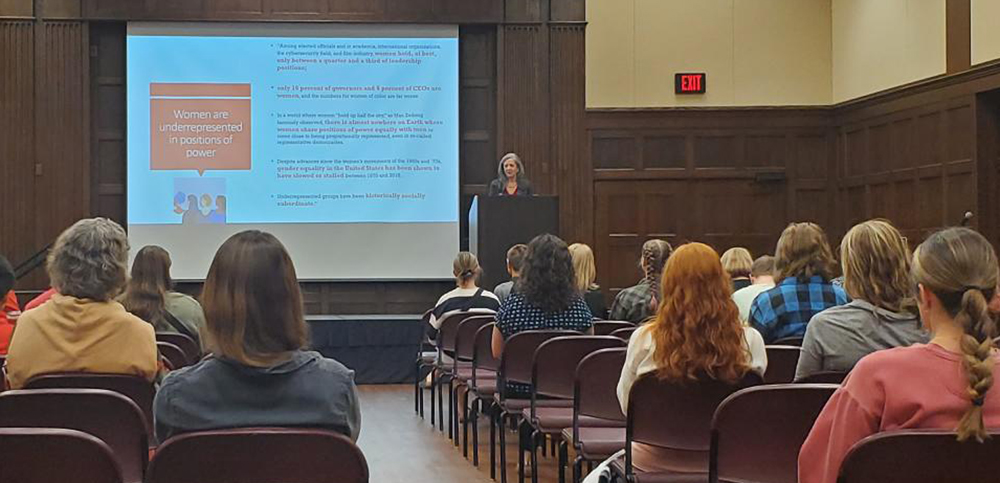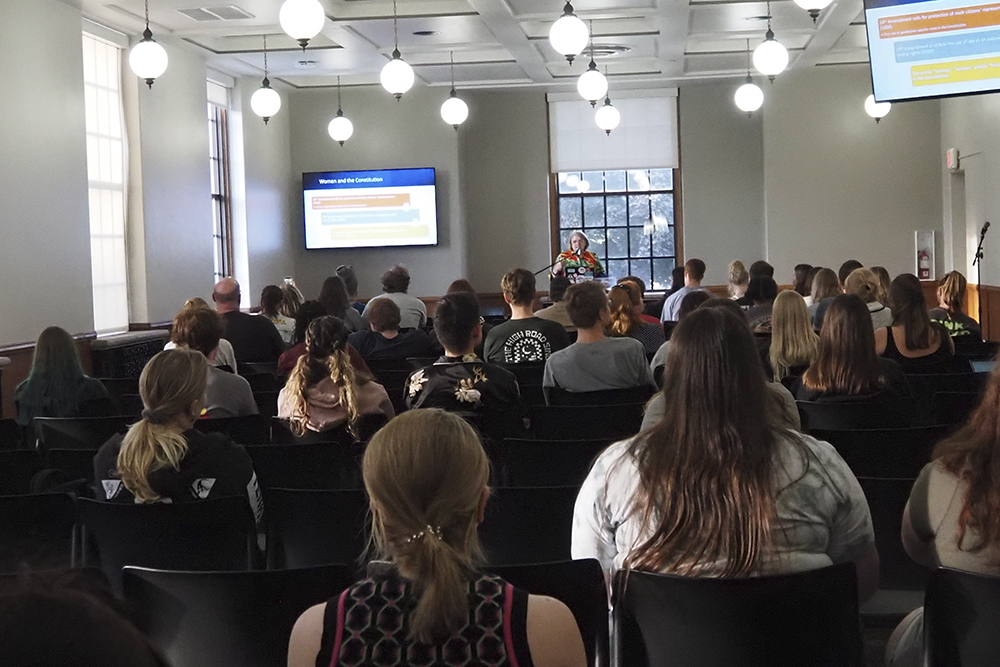The Carrie Chapman Catt Center for Women and Politics was pleased to host two lectures in September – “Women, Power and Rape Culture: The Politics and Policy of Underrepresentation” by Bonnie Stabile – associate dean for student and academic affairs and associate professor in the Schar School of Policy and Government and founder and director of the Gender and Policy (GAP) Center at George Mason University – on Sept. 12 and “It’s Not Done: Women’s Constitutional Equality” by Catt Center director and ISU political science professor Karen M. Kedrowski on Sept 21.
Stabile’s presentation was held in the Great Hall of the Memorial Union. She was introduced by Alyssa Rodriguez, a senior in human development and family studies with minors in public relations and political science and a student voter engagement intern with the Catt Center.
In her presentation, Stabile explained that because public policies are developed to address public problems, we should be responsible for measuring the outcomes of those policies and that the outcomes ought to be equitable and a reflection of our values.

Saying that every policy issue has some gendered component, Stabile used statistics and examples from her 2022 book to examine the success—or lack of—in implementing effective public policy regarding sexual assault and harassment.
“There’s still almost no place on Earth where women share positions of power equally with men,” Stabile stated. “Just as women are underrepresented in power, they’re overrepresented in adverse policy outcomes.”
When discussing campus sexual assault, Stabile held up several examples of organizations whose young female leaders – many of them survivors of sexual assault themselves – are providing a template for improving public policy.
“If people who are experiencing problems are not represented, their voices are less likely to be heard and their understanding from having experienced problems will not get reflected in the policies,” Stabile said.
At the end of the presentation, Stabile stressed the importance of a balance of representation to achieve better policy outcomes.
“Outcomes are better not just for women, but for all in society when we have voices proportionately represented,” she said. “Only with the clout conferred by political and economic power can women turn the tide towards justice and rewrite the narrative that silenced them for so long.”
Stabile’s lecture was sponsored by the Catt Center, the Women’s and Gender Studies Program, and the Committee on Lectures (funded by Student Government).
On Sept. 12, Karen Kedrowski presented Iowa State’s annual Constitution Day lecture in 2630 Memorial Union. She was introduced by Paola Martinez, a junior in majoring in political science and a student voter engagement intern with the Catt Center.
Kedrowski opened her presentation by saying that she’d be talking about something that is actually not in the Constitution: a guarantee of equal rights for women. She then looked at how civil rights are defined in the Constitution. She explained that the 14th Amendment, which was ratified in 1868 following the Civil War, guarantees citizens due process and equal protection of the law and protects the voting rights of citizens – but only male citizens.

“Now, what’s interesting about this is that this is the first time that a sex-specific word is inserted into the Constitution,” Kedrowski said. And, she added, it’s still there. “So technically, the Constitution only protects the voting rights of male citizens.”
The next occurrence of a gender-specific reference, said Kedrowski, is in the 19th Amendment. Although this amendment did enfranchise millions of women, Kedrowski pointed out that the words “woman,” “women,” and “female” do not appear in the amendment.
“It’s sometimes phrased that it gave women the right to vote. It’s not really a guarantee of a right to vote as much as it is an elimination of a reason [sex] to deprive someone to vote.”
Kedrowski presented the arguments for and against the ERA that were used from its introduction in 1923 through the 1950s, how several events in the 1960s led to a renewed interest in feminism, and how several legislative actions and U.S. Supreme Court decisions in the 1970s began to reduce legal barriers to women.
The ERA was introduced in some form in every Congress until 1972, when it finally passed Congress and went to the states for ratification, with a seven-year time limit. The first ratifications happened very quickly, Kedrowski said, but stopped in 1977. In 1979, 35 states had ratified the amendment but five states had rescinded their ratifications.
Kedrowski explained that the addition of the 27th Amendment to the Constitution, which was passed as part of the original Bill of Rights in 1789 but was not ratified and added to the Constitution until 1992, raised the question of the constitutionality of the ERA’s time limit and of the five states’ rescissions, and therefore the viability of the ERA.
With the addition of three more states’ ratifications in 2017, 2018 and 2020; one more rescission; conflicting guidances from two presidential administrations; several court cases; and several Congressional resolutions, Kedrowski described the ERA as a “zombie” amendment – “It’s not really alive, but not really dead.”
Kedrowski’s lecture was sponsored by the Catt Center, the Department of Political Science and the Committee on Lectures.
Recording of both lectures are available at https://www.lectures.iastate.edu/recordings/available-recordings.